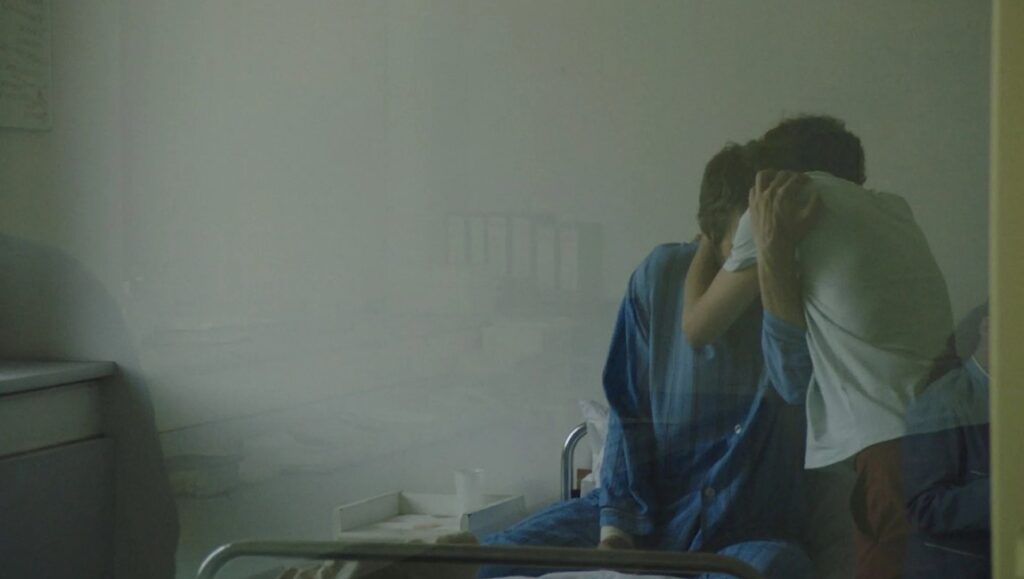Suicide narratives are dominated by two extremes: the undermined sense that all knowledge about the person who has died is now a hopelessly incomplete, even false kind of knowledge, and the deterministic profile of the person that can be pieced together by the medical paper trail they leave behind. Juraj Lerotić’s Safe Place is crafted in a way that directly addresses, then evades, both of these problems; it exists in the conditional tense rather than the wake of a suicide attempt. At first, the film appears to be up to something much more familiar: In a flurry of real-time activity, Bruno (Lerotić) breaks down an apartment door to reach his unresponsive brother, Damir (Goran Marković). Estimating he has arrived hours after Damir’s attempt, he calls for help, and paramedics arrive, cops arrive, the brothers’ mother arrives, and each brings a new wave of questions. Bruno, unable to accompany Damir in an ambulance, keeps the pace up by running on foot to the hospital. If Lerotić seems to be engineering a study in tension, he quickly dissuades this notion not long after: following an introduction to the diagnostic distrust of medical professionals, the first extended meeting between Bruno and Damir cleaves through any notion that we are merely watching a ticking-clock, social-realist drama.
Safe Place will not be a study of psychology, tragedy, recovery, or family dynamics. In a single moment, what we’re seeing is reconfigured — you could call it a response to Camus’ provocative statement that “an act like this is prepared within the silence of the heart, as is a great work of art.” That is, it takes the question of Damir’s motivation, which Marković plays as an unutterable struggle — most of the time, the actor projects a rigid calm, and answers any question, more often than not, “Okay…” — and deems the entire notion as inextricable from what else could yet occur beyond the attempt. Rather than a form of time that might explain Damir’s situation as a problem (like flashbacks), Lerotić’s film unfolds as a series of implicated presents — episodes that restage a form of crisis in other locations, with Damir joined by his mother and brother. As the Bruno and Damir meeting ensures, we know the trajectory of what will happen; it seems fixed, but as Lerotić’s intervention suggests, the sum of the consequences of each potential action taken by Bruno and his mother must still be accounted for.
Given the exponential number of paths that this film has access to, it’s worth noting that Lerotić prefers to keep things as contained as possible. The film sticks with the trio, and aside from onscreen figures reached by phone, admits no one else into this universe. Even though the meeting between Damir and Bruno suggests that anything is possible, that no rule can’t be broken in Safe Place’s presentation, this never comes close to happening. Most of the film is delivered in carefully measured doses of dialogue, destabilizing gestures, and a dichotomy of images: interiors appear to us as if covered in a gray mist, while exteriors pop with near-fluorescent greens. In other words, there’s no mistaking Safe Place for a problem-message movie. But some of those isolated gestures are cleverly placed. Pressed by an investigator about why he stores a gun in his apartment, Bruno answers that it is merely a prop — he works in TV — which neutralizes the situation. Similarly, faced with the trial of enduring a waiting room after a suicide attempt, with concern written on his face and blood on his shirt, in a single motion, he finds a way to reverse the problem, an elegant illustration of the film’s shape and its suppleness with artifice — like a more desperate version of Tilda Swinton’s handkerchief inversion in Memoria.
But it would also be outsized praise to say Lerotić is truly working at a level where we can trust every one of his moves. That the film’s premise is apparently based on an event that impacted his family — to the point where, outside the trio, the film declares that names have not been changed — grants him a great deal of good will. But despite allowing his film such grand and changeable parameters, by the end, matters dissipate into a final image of nostalgic cliche. If this film is a resurrection, it’s by turns a startling and intelligent one — but one that ultimately fails to seize the possibilities of its venture like similarly inclined time-splitters Je t’aime, je t’aime and Peppermint Candy. Still, that a first feature invites such comparisons at all is a testament to the film’s gambit, which, at the very least, marks Lerotić as a director interested less in parcelling out memories and more in delving into the inseparable strata of past, present, and future.
Published as part of InRO Weekly — Volume 1, Issue 24
Enjoy our content? Want early access to features, interviews, and more? Support us on Patreon!


Comments are closed.